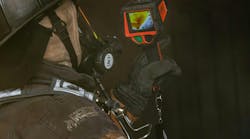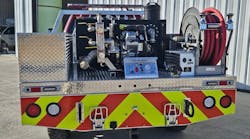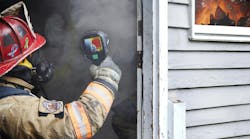One of the things I’ve observed that continues to inspire me is the willingness of members of the fire service to respond to any type of emergency. This noble unselfishness makes the job of a firefighter extraordinarily broad. While the general public may think firefighters respond to just structure fires, those of us in the trade know all too well the range of calls to which fire departments must be able to respond.
One area that sometimes goes unnoticed is technical rescue. Some departments have specialized response groups or technical rescue forces that respond to emergencies that involve rope, swift-water, confined-space and trench rescue. In addition, these forces also respond to vehicle extrication, tornado, flood and general search rescues. When dealing with specialized rescue situations, firefighters can use thermal imagers (TIs) very effectively for a range of operations.
Rescue applications
Thermal imaging devices that are tailored exclusively for specialized rescues, such as for specific operations for building collapse or long-range surveillance may be ideal for certain departments. Some agencies even use gyros-mounted thermal imagers on helicopters for search and rescue.
These specialized products aid wonderfully in specific operations, but are usually impractical for the average department; a helicopter-mounted TI, for example, costs well into six figures. For most, this means planning for deployments that might involve specialized rescue missions around the available fleet of thermal imagers. Also, specialized TIs or those mounted to other equipment likely require intensive training or trained operators. A fire service thermal imager is simple in comparison. Since first responders are typically first on the scene, they most likely will be using a thermal imager designed for firefighting.
Thermal imagers used for fire service operations are typically fixed-focus and relatively short-range tools, designed principally for interior fire attack. Still, these units are capable of detecting a human body form at several hundred feet or farther, depending on the temperature of the surrounding objects and overall environmental conditions. To search a wide area, such as an industrial facility or an expansive open area, a TI can be invaluable for conducting the search, performing risk assessments or assisting in prioritizing resources.
When conducting a confined-space rescue scenario, departments can put firefighting TIs to valuable use. An attic, cellar or basement, following a natural disaster such as a tornado, is a dark, closed-in, unfamiliar and potentially hazardous area. It is also an enormously beneficial environment in which to employ TIs to let crews easily see their surroundings and navigate in the dark, particularly when scene lighting is unavailable or impractical. In these situations, the firefighting TI can help locate a trapped or injured person and bring him or her to safety.
A TI can also be used during confined-space rescue to delay a structure collapse or secure the scene. When conducting victim searches, firefighters should look for out-of-place heat signatures and limbs and extremities protruding from debris, under tables or around objects. These signal possible human presence.
When used appropriately, firefighting TIs make the search and rescue process faster and more effective, revealing critical details capably even when no fire is present.
Several years ago, a fire department in Mississippi used a firefighting thermal imager to find a missing child after a tornado ripped through a small community. Members of a local family didn’t know they were in the path of a tornado since the storm hit in the middle of the night. The powerful tornado destroyed the family’s home. Once the tornado had passed, the mother and father realized that one of their children was missing. The devastated family panicked and began searching frantically, while neighbors and emergency responders, arriving on scene in their personal vehicles, joined the effort. Even with numerous people searching, no one found the child through the massive amount of debris.
Fortunately, two apparatus from the local fire department arrived on the scene equipped with TIs. The firefighters scanned the debris field using the TIs, and the fire chief noticed a section of wall that was warmer than the rest of the debris. Behind this wall was the unconscious child, injured but alive. The fire chief is convinced that the TI saved hours of search time and probably saved the child’s life. In this real-life event, the use of the thermal imager provided firefighters with a more complete picture of the space, allowing for better and faster searching and turning likely heartbreak into a success story.
Fire departments cannot always afford specialized equipment, apparatus or training. The good news is that, for specialized rescues, most departments have access to firefighting thermal imagers that are equal to the task. Thus, first responder agencies can, when duty calls or disaster strikes, immediately use their thermal imaging capabilities even while awaiting the response of an organized and specialized technical rescue force.
Saving time saves lives. If your department doesn’t own a firefighting thermal imager, being better prepared for rescues is yet another reason to get equipped.
pull quote:
Thermal imagers are very effective for a range of technical rescue operations.





